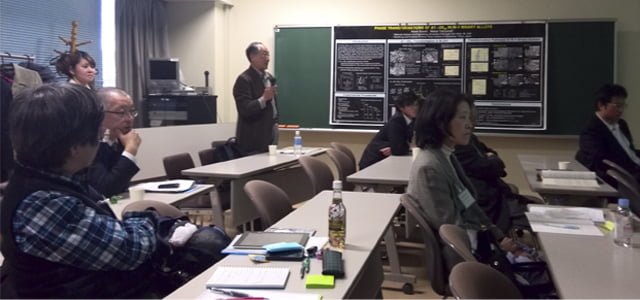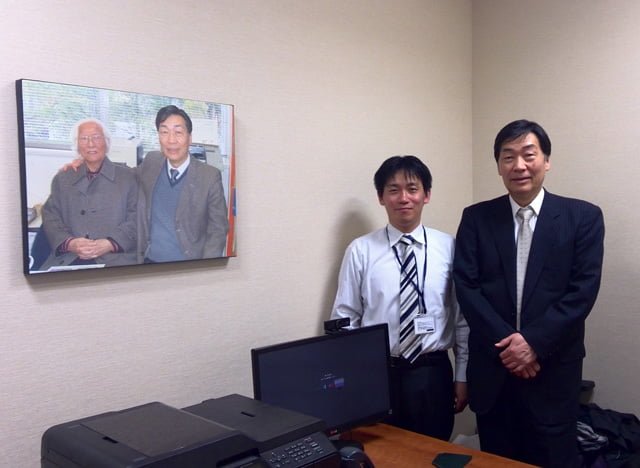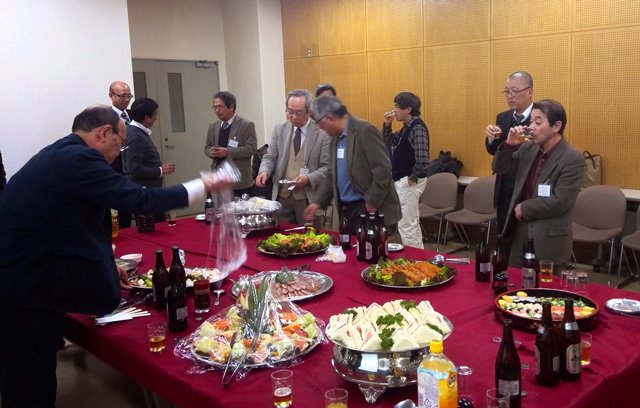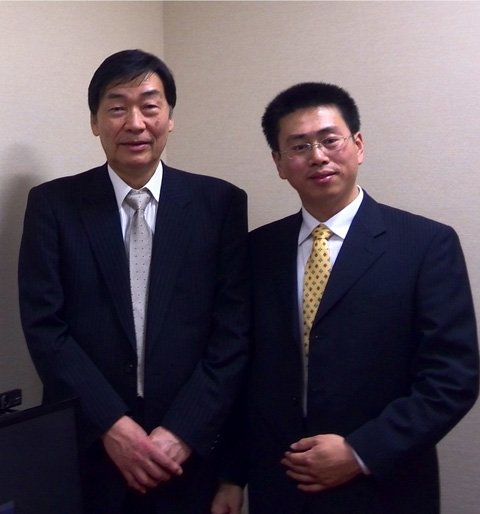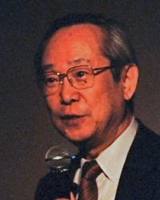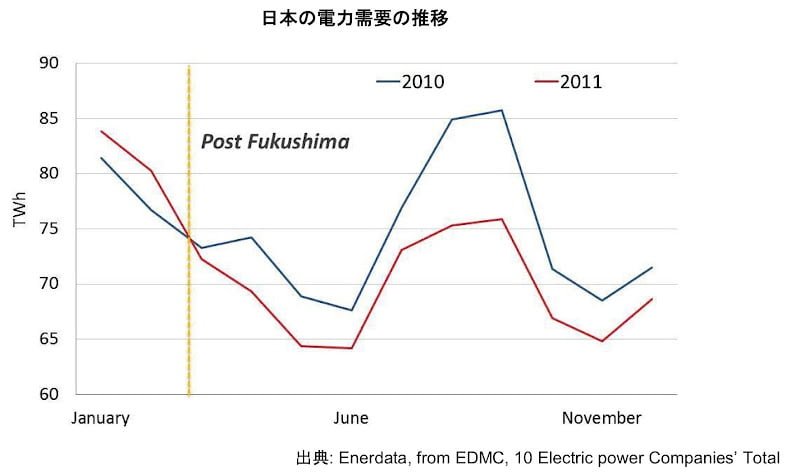In the global field of LENR, few groups match the productivity of Japanese researchers. With a longtime history of collaboration between academia and industry, the rich and wide-ranging scientific results have enabled groups on the island to develop long-term data on systems, successfully reproduce key experiments, and grow a diverse and comprehensive team of researchers training young scientists.
Now, a collection of stunning results is reported from a two-year collaborative project focused on generating excess heat with the Metal Hydrogen Energy MHE reactor within a budget of 1 million dollars.
The six institutions of Kyushu University, Tohoku University, Nagoya University, Kobe University, the Nissan Motors Co. and Technova Inc, a division of Toyota, worked together from design to analysis, each contributing their specialty. The goal was to verify the existence of the Anomalous Heat Effect AHE in nano-metal and hydrogen gas interactions, and seek to control the effect.
The first MHE arose in 2012 at Kobe University, and now, there’s an additional reactor at Tohoku University, one with a new calorimetry design for comparative results.
A total of 16 collaborative tests have generated an average of 7-8 Watts excess thermal power, but that bumps up to 20 Watts excess on some sample runs, with no appreciable radiation from gammas or neutrons above background levels detected.
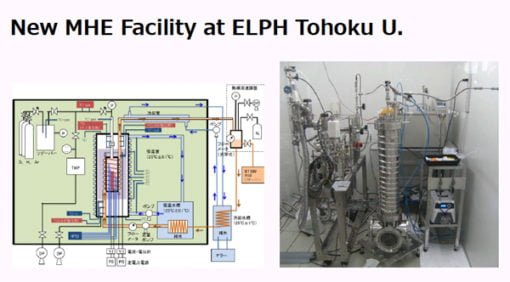
According to the team, the regular success in generating heat is due to the composite materials specially developed to host the reaction, which researchers there say is required to initiate a reaction in their system. Nano-powder mixes 2-10 nanometers wide of palladium, nickel, and zirconium, and copper, nickel and zirconium, have provided excess heat greater than single palladium or nickel metal reactors.
The MHE group is also using larger amounts of host material. 200-gram samples are divided into two 100-gram samples, and sent to different labs. When tested under the same conditions, similar heat profiles are observed, producing 2-8 Watts for a week. That wouldn’t be news in any other field, but in LENR/cold fusion, this is a huge step towards nailing down this reaction.
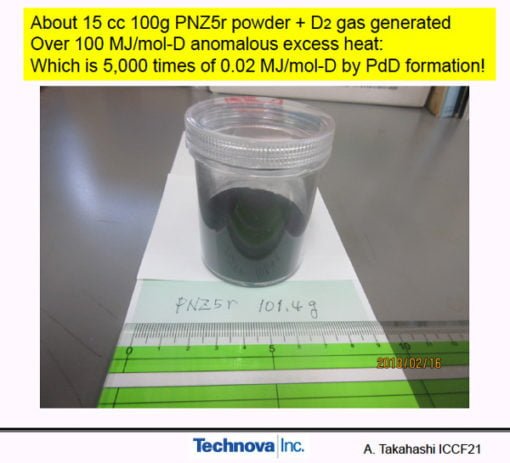
One Cu-Ni-Zir sample produced an anomalous heat burst peaking at 110 Watts thermal, then, dropping down to 2 Watts sustained for a day. The total energy produced by the burst: 300 kiloJoules.
The largest excess heat data was generated in the 14th collaborative experiment when a 124-gram palladium-nickel-zirconium sample generated 10-20 Watts thermal power for a month.
 Dr. Akito Takahashi is one of the members on this team that has been working on the problem of cold fusion reproducibility since the early days. A nuclear engineer and senior advisor in the Thermal Energy and Technology group with Technova, he is one of the stars of a crowded Japanese field teeming with talent, and whose range of research have helped transform investigations into the Anomalous Heat Effect into a fast evolving field of Condensed Matter Nuclear Science, where the parade of nuclear effects keep on surprising scientists.
Dr. Akito Takahashi is one of the members on this team that has been working on the problem of cold fusion reproducibility since the early days. A nuclear engineer and senior advisor in the Thermal Energy and Technology group with Technova, he is one of the stars of a crowded Japanese field teeming with talent, and whose range of research have helped transform investigations into the Anomalous Heat Effect into a fast evolving field of Condensed Matter Nuclear Science, where the parade of nuclear effects keep on surprising scientists.
He spoke at the recent ICCF-21 conference and gave an update on results from the 2-year collaborative project that he led, and what’s next for the perrenial MHE heat machine. You can watch his presentation on Youtube here and download the ICCF-21 presentation file here.
Cold Fusion Now! asked Dr. Akito Takahashi about his career in cold fusion, the MHE project, and the theoretical model he developed to try to explain and give direction to research.
RUBY Dr. Takahashi, you are an original cold fusion scientist. Can you tell us what prompted you to first start researching cold fusion, and how long did it take for you to get results?
AT In March-May 1989 after the F-P big claim of cold fusion, I was skeptical. However, the Tienanmen Crisis in Beijing China gave me a chance to get involved in cold fusion research. At that time I was busily involved in the DT fusion blanket neutronics project the US, Japan and China were collaborating on. Suddenly, the project was suspended due to the Tienanmen Crisis and I had some free time.
My expertise was in neutron physics experiment since 1965. If cold fusion is real, the F-P heavy water electrolysis should emit 2.45 MeV neutrons by d-d fusion as Steve Jones of BYU claimed. This was the common sense effect that mainstream nuclear physics people (I was one of them) would look for.
Curiosity moved me to try neutron detection with spectroscopy, which I was very familiar with, by heavy water electrolysis with palladium cathode. After several weeks in trial, I could see weak component of 2.45 MeV d-d fusion neutrons. However, the observed neutron level was very weak. If the F-P claim of anomalous thermal power (heat) in a few watts level was by cold d-d fusion reactions, ca. ten-to-the 12th order 10^12 neutrons per watt were lethal, but my observed neutron level was very very weak at ten-to-the MINUS 13th order 10^-13 level of required d-d fusion reactions. It was so curious to me. Something new and nuclear-like should have happened.
In a few weeks, I proposed a model and send a short note to journal (JNST: Journal of Nuclear Science and Technology). The proposed model is the multi-body deuteron fusion theory in deuterium-absorbed metal. After about 25 years elaboration, the theory has been established as CCF (condensed cluster fusion) theory. The TSC (tetrahedral symmetric condensation) theory is the key term of theory.
Along with theoretical works, I have done many experiments on anomalous heat effect and nuclear products detection by using designed CF experimental devices for the last 30 years, under the view of CCF model guide line. Curiosity is what drives me.
Recently, I have become aware of repeated observations with convincing experimental results by the deuterium or light-hydrogen gas charging method using new concept nano-composite metal powders, which are consistent with theoretical mechanisms of CCF theory in combination of dynamic interactions of nuclear, molecular, surface-catalytic and metal solid state physics. By doing so, it has past the 30-years-mark of continued work.
RUBY You and the team of collaborators working with you, are continuing to reach for bigger results with the Metal Hydrogen Energy system, and you are getting it! What is so special about the materials you are now using?
AT Our knowledge now is: Pure palladium and nickel (even nano-powders) do not work to produce sustaining large (namely, several tens watts, currently) excess heat at practically useable elevated temperatures as 300-400 degree C. We need bi-metallic nano-composite (or nano-islands) structures in ceramics supporter flakes. Pd1Ni7/zirconia and Cu1Ni7/zirconia are typical hopeful powder samples.
We have started with 50-100g powder samples in MHE reaction chamber, and observed several-weeks sustaining anomalous heat of ca. 10 watts thermal power level, by deuterium or H-charging. Integrated excess heat in a month run reached typically 300 MJ per mol-D. So, produced energy density is more than 1000 times of gasoline-burning and is very difficult to explain by chemical reaction mechanisms and we are considering the CCF-like nuclear origin.
However, about 10 watts thermal power is still considerably low power density to be applied for industrial energy devices; we need scaling-up. To increase amount of sample is a first simple approach, which we are now attempting. To manufacture nano-composite powders with controlled nano-islands (in 2-10 nm size) is an essential approach.
In the latest result that we reported at JCF19 Meeting, November 9, 2018 in Morioka Japan, we observed anomalously large heat burst. The burst happened in about 100 seconds with approximately 3 kW thermal power, impulsively. If we will be able to control and elongate this level power generation for much longer time, we will be approaching the goal.
RUBY This project is a an excellent example of the longtime cooperation between scientists in your country, and given the results, appears to be a successful model. How would you characterize the relationship between academia and industry in Japan?
AT We have done only minimum effort to organize available 6 groups (4 university groups and two company groups) to implement the NEDO-MHE 2015-2017 project. I was the leader and directed the experimental plans for collaboration works. Researchers have joined and moved from north (Sendai Tohoku University) to west (Kobe University, and Kyushu University) for experiments, and some-times gathered in Tokyo for steering/discussion meetings.
I hope this will be a seed for next step to set-up a bigger consortium of industrial groups and university academic groups. Our latest results on anomalous heat effect can be explained only by nuclear origin and we are struggling with NEDO’s negative stance to funding Nuclear Origin Research & Development.
MEXT (ministry of education, science and culture) is promoting nuclear R&D in a monopoly-like way by sending big funds to ITER and others, and are not brave enough to provide some portion of funding to MHE R&D. So, the situation is somehow similar to US and EU.
RUBY You’ve been struggling to model this elusive reaction since the very beginning. Can you describe in layman’s terms some of the main features of the TSC model, and how is this model tied to your experimental work?
AT Theoretically, in my view, there are no molecular physics processes available in nature for two deuterons or protons to approach close enough to make visible nuclear reactions. Only transient clusters like 4, 6 and 8 deuterons (or protons) with quantum-mechanically orthogonally coupled 4, 8 and 6 electron-clouds can dynamically condense one-way and make collapse in very closed inter-nuclear distances to induce multi-body strong-force (for D) or weak-strong-force (for H) fusion reactions.
These CCF reactions do not produce primary neutrons and gamma rays. The geometrical coupling of 4 deuterons (or protons) and 4 electron-clouds under tetrahedron-tetrahedron orthogonal arrangement makes TSC, tetrahedral symmetric condensate, that is a transient cluster state and not stable.
You may imagine two D2 or H2 molecules coupling with 90 degree crossing configuration. This configuration is not stable in free space (namely in gas) and is also difficult to form in D2 or H2 gas due to bouncing by mutual collision. However, once the rotation freedom of D2 or H2 is frozen by trapping at a surface catalytic site (a sub-nano hole) of binary metal nano-particle, another incident (or out-going) D2 or H2 molecule on the surface catalytic site can make transient TSC formation with very enhanced rate.
Once TSC forms, it very rapidly (in 1-2 femto seconds) condenses in one-through way to get to a collapsing state in a nuclear-force-exchanging close distance for 4 deuterons or protons+electrons. The resultant multi-body fusion happens to produce low energy charged particles (helium, deuterium and proton).
Secondary reactions may generate neutrons and gamma-rays with very weak levels as less than 10^-13 order of primary charged particles. So radiation will be actually neglected in industrial devices generating several kW power.
RUBY The 19th Meeting of CF Research Society just wrapped up. What can you say about some of the other results presented there?
AT Other interesting reports besides ours were two instances of AHE (anomalous heat effect) observed by the DSC (differential scanning calorimetry ) apparatus at Kyushu University. That unit is particularly for nano-metals and H-gas interactions with PNZ-type and Ni-Al and Ti-Al samples at 300-800 degree C.
Tohoku group reported AHE with many temperature and gas pressure spikes, which looked very similar in effect, though with smaller scale, to a very large burst/spike of AHE by a Cu-Ni/zirconia powder sample as observed at Kobe-U/Technova.
Iwate University group are reporting basic studies on H-gas and multi-layer nano-composite metal samples. Kyoto University group is extending/improving Yamaguchi-type metal-D-gas induced AHE by electric pulse trigger.
RUBY I’m sure you have heard about Dr. Tadahiko Mizuno’s laboratory damaged by the earthquake. The community reached out to him with donations to help re-build. Were you effected by the earthquake at all?
AT In June we had big quake at Osaka to damage houses, but MHE apparatus at Kobe was OK.
RUBY Dr. Takahashi, we are approaching the 30-year mark since the announcement of cold fusion, and every experimental fact has been hard fought for. Now, you are finally realizing some of the fruits of that labor and getting more heat than ever.
What is it about cold fusion that compelled you to spend a career struggling in this most difficult field?
AT Of course, we want to solve the global warming effect created by the consumption of fossil fuels like oil and we are planning to develop eco-friendly, radiation-free, compact, novel energy generators, hopefully in 30-50 years. The so-called cold fusion reaction, and in my view, the CCF, has great potential to provide an eternal solution, helping us to escape the oil-age.
However, as a scientist, it has been curiosity that has pushed me to find the real mechanisms of the claimed mystery and miracles of the AHE and radiation-less nuclear processes. My answer now is that CCF governs it. I will continue to work on what I can do until it becomes impossible.
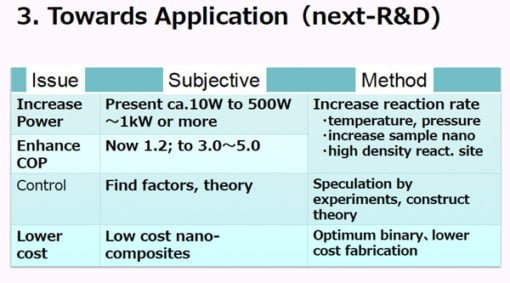
Hear Dr. Akito Takahashi speak about the MHE project at the 21st International Conference on Condensed Matter Nuclear Science https://www.iccf21.com/.


 It has also battered the laboratory of veteran LENR researcher Tadahiko Mizuno, who has lost valuable research equipment, and building damage will require the lab to move.
It has also battered the laboratory of veteran LENR researcher Tadahiko Mizuno, who has lost valuable research equipment, and building damage will require the lab to move.
